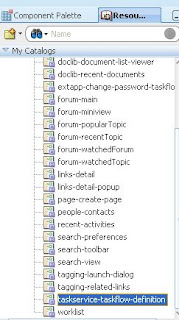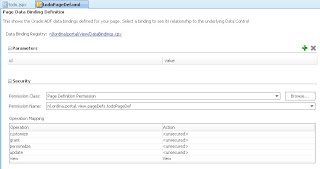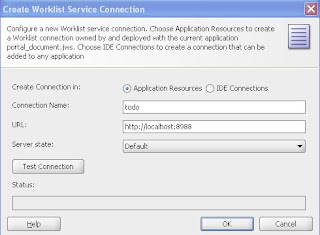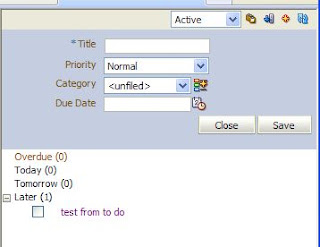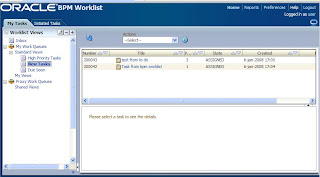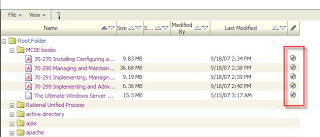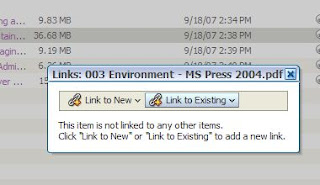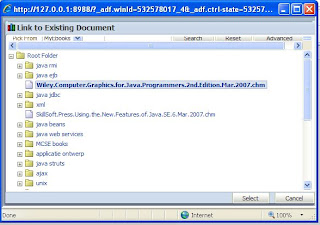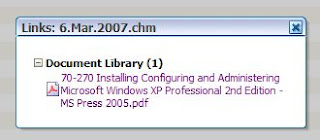In the esb server for the customer we want to use queues between the message handling system and the backoffices databases. In the Oracle database you can do this with Oracle AQ or with Oracle jms. We want to use the jms queue because we don't know in the future we still want to use Oracle esb and then it is easier in an other program to connect to the Oracle jms implementation then to connect to Oracle AQ. So we don't have to change the queues. You can easily create a jms queue in the database
First we give the schema user scott permission to create a queue.
grant aq_user_role to scott;
grant execute on DBMS_AQADM to scott;
We can create the queue table
begin
sys.dbms_aqadm.create_queue_table(
queue_table => 'JMS_IN_TABLE',
queue_payload_type => 'SYS.AQ$_JMS_MESSAGE',
sort_list => 'PRIORITY, ENQ_TIME',
compatible => '10.0.0',
primary_instance => 0,
secondary_instance => 0,
storage_clause => 'tablespace users pctfree 10 initrans 1 maxtrans 255 storage ( initial 64K minextents 1 maxextents unlimited )');
end;
/
What important is that we use 'SYS.AQ$_JMS_MESSAGE' as payload type and the dequeue order is first priority and then the enqueue time.
Now we can create the queue
begin
sys.dbms_aqadm.create_queue(
queue_name => 'JMS_IN',
queue_table => 'JMS_IN_TABLE',
queue_type => sys.dbms_aqadm.normal_queue);
end;
/
If you want to dequeue and enqueue this queue we have to enable this first
begin
dbms_aqadm.start_queue( queue_name =>'JMS_IN' ,enqueue => true ,dequeue => true );
end;
/
With this plsql code we can add a message to the queue
declare
l_message clob := '';
v_enqueue_options dbms_aq.enqueue_options_t;
v_msg_props dbms_aq.message_properties_t;
v_msg_id RAW(16);
v_message SYS.AQ$_JMS_MESSAGE := SYS.AQ$_JMS_MESSAGE.construct(DBMS_AQ.JMS_TEXT_MESSAGE);
begin
l_message := '<data-message><runid>210</runid></data-message>';
v_message.set_text(xmltype(l_message).getstringval());
dbms_aq.enqueue(queue_name => 'JMS_IN'
,enqueue_options => v_enqueue_options
,message_properties => v_msg_props
,payload => v_message
,msgid => v_msg_id);
commit;
end;
/
Now we are ready to use this in the ESB. We can add a new JMS adapter in the composite view.
Choose database as oems jms provider
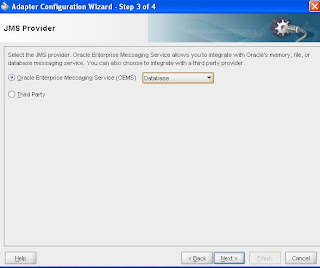
Create a new database connection to scott.
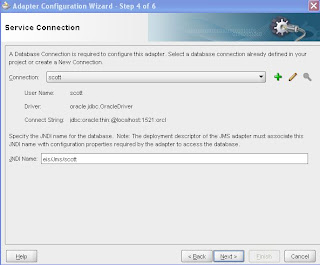
If you want to enqueue a message then choose produce and if you want to dequeue choose consumer
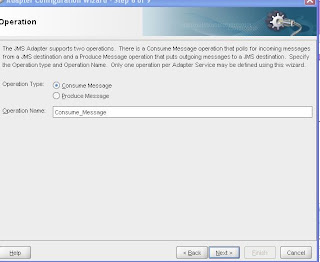
Give the resource provider a name ( we need this name later )and select the destination.

Now we add the resource provider in the application.xml in the config folder, use the same name as above
<resource-provider class="oracle.jms.OjmsContext" name="jms">
<description>oc4j-jms loop back resource provider</description>
<property name="url" value="jdbc:oracle:thin:scott/tiger@localhost:1521:orcl"/>
</resource-provider>
The last step is to configure the jms adapter. Go to the deployment folder then to the default and JmsAdapter folder. Here we edit the oc4j-ra.xml where we add a new connection
Location is the database connection name and change the user and password properties. We have to change the value of connectionFactoryLocation property. Between /resource and /QueueConnectionFactoryLocation we have to add the resource provider name.
<connection-factory connector-name="Jms Adapter" location="eis/Jms/scott">
<config-property name="connectionFactoryLocation" value="java:comp/resource/jms/QueueConnectionFactories/myQCF" encoded-credential="false"/>
<config-property name="factoryProperties" value="" encoded-credential="false"/>
<config-property name="acknowledgeMode" value="AUTO_ACKNOWLEDGE" encoded-credential="false"/>
<config-property name="isTopic" value="false" encoded-credential="false"/>
<config-property name="isTransacted" value="true" encoded-credential="false"/>
<config-property name="username" value="scott" encoded-credential="false"/>
<config-property name="password" value="tiger" encoded-credential="false"/>
</connection-factory>
Now we can use the jms queue in the esb.




































